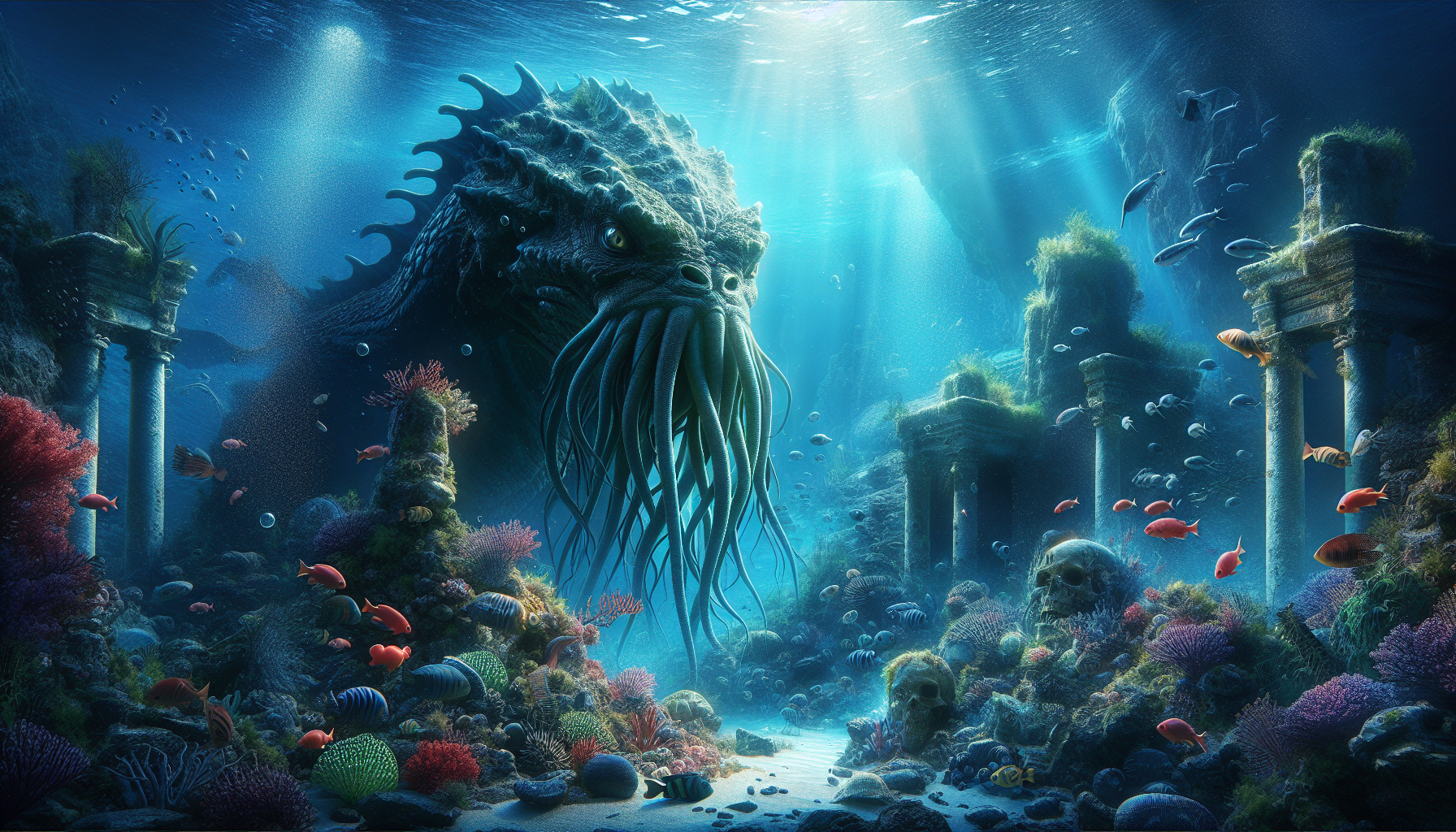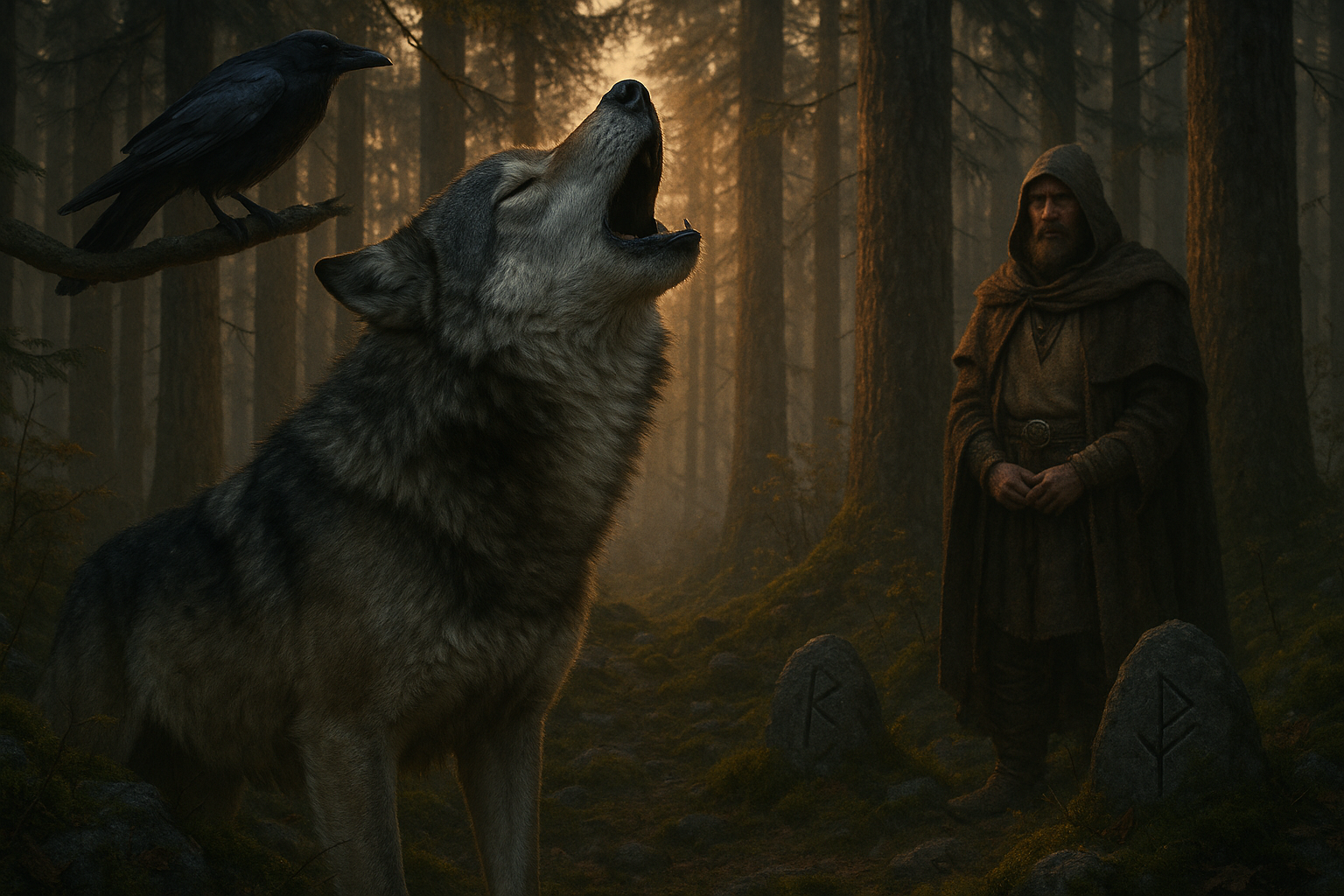The ocean has always been a realm of mystery and wonder, a vast and deep expanse that has fueled human imagination for centuries. Tales of mythical creatures emerging from its depths have captivated storytellers and audiences alike, transcending cultures and generations. Among these legendary beings, the Kraken stands out as one of the most formidable and awe-inspiring. Often depicted as a gargantuan cephalopod, this creature has been the subject of numerous myths, seafaring legends, and speculative fiction. But how much of what we know about the Kraken is rooted in fact, and how much is pure fantasy? 🌊
Our journey begins by diving deep into the history of the Kraken legend, tracing its origins back to the Nordic sagas and medieval lore. These tales were passed down through generations of sailors and coastal dwellers, each adding their own embellishments to the story of a beast that could drag entire ships beneath the waves. But what were the real-life encounters that might have inspired these chilling narratives? We will explore historical accounts and examine whether these stories were born out of genuine encounters with mysterious sea creatures or were simply products of the human penchant for storytelling and exaggeration.
As we navigate through the ocean of myths, we will also delve into the world of marine biology to uncover the truth behind the supposed sightings of the Kraken. Is it possible that ancient mariners were actually observing colossal squids or other large sea creatures that science has only recently begun to understand? 🦑 Through expert interviews and scientific research, we’ll dissect the anatomy and behavior of these real-life behemoths, comparing them to the mythical descriptions and assessing the likelihood of their existence. Could it be that the Kraken is not entirely a creature of fiction, but rather a misunderstood inhabitant of the deep?
Finally, we’ll explore the cultural impact of the Kraken, examining how this mythical creature has permeated literature, art, and popular culture. From Jules Verne’s “Twenty Thousand Leagues Under the Sea” to the modern cinematic portrayals in blockbuster films, the Kraken continues to capture the human imagination. What is it about this legendary beast that resonates so deeply with us? By the end of our exploration, you’ll have a comprehensive understanding of the Kraken, armed with the knowledge to distinguish between fact and fiction. Whether you’re a marine enthusiast, a lover of mythology, or simply curious about the secrets of the deep blue sea, prepare to have your preconceptions challenged and your imagination sparked. 🌟
The Legend of the Kraken: Origins and Cultural Impact
The tale of the Kraken has captivated the human imagination for centuries, often described as a massive sea monster lurking in the depths of the ocean, ready to drag unsuspecting sailors into the abyss. Originating in Norse mythology, the Kraken was first mentioned in a travelogue by Francesco Negri in 1700, where it was depicted as a giant cephalopod-like creature. This creature became an integral part of maritime folklore, inspiring countless stories and artistic depictions that have persisted throughout the ages.
Norse legends portray the Kraken as a terrifying beast capable of creating whirlpools and wrecking entire ships. As trade routes expanded and sailors ventured further into uncharted waters, the fear of encountering the Kraken grew. This monster became synonymous with the mysteries and dangers of the sea, serving as a symbol of the unknown that lay beneath the ocean’s surface. The Kraken has left an indelible mark on popular culture, inspiring works like Jules Verne’s “Twenty Thousand Leagues Under the Sea” and appearing in modern franchises like “Pirates of the Caribbean.”
The cultural impact of the Kraken is not limited to literature and film. Its image has been appropriated in advertising, brand logos, and even sports team mascots. This widespread influence underscores the enduring fascination with the Kraken and the broader mysteries of the ocean. However, to understand the Kraken’s place in contemporary culture, we must first examine its mythical origins and how these tales have evolved over time. For an engaging introduction to the Kraken mythos, watch this insightful video: The Kraken: Myth and Reality – Mythology & Fiction Explained.
Biological Basis for the Kraken: Real Creatures of the Deep
While the Kraken has long been regarded as a mythical creature, there is scientific evidence to suggest that it may have been inspired by real animals. The colossal and giant squids, residing in the deep ocean, possess features that closely align with traditional descriptions of the Kraken. These elusive cephalopods can reach lengths of up to 43 feet, with large tentacles and eyes that are the size of dinner plates. Such characteristics have likely fueled the Kraken legends, providing a biological basis for these sea monster tales.
Scientific exploration of the deep sea has revealed the remarkable adaptability and resilience of these giant squids. They inhabit depths of 1,000 to 3,000 feet and have evolved unique physiological traits to survive in such an extreme environment. These include a highly developed nervous system, sophisticated camouflage abilities, and a unique propulsion mechanism that allows them to move with grace and agility despite their enormous size. Understanding these creatures offers a glimpse into the world that might have inspired the Kraken mythology.
Further research into the behavioral patterns and ecology of giant squids has provided insight into their role in the marine food web. As apex predators, they play a critical part in maintaining the balance of ocean ecosystems. This new understanding challenges the traditional image of the Kraken as a malevolent force, suggesting instead a creature of great ecological importance. To explore the fascinating world of giant squids, check out the video below: Inside the Belly of a Squid – Deep Ocean Series.
Separating Myth from Reality: Kraken Sightings and Scientific Analysis
Throughout history, numerous accounts of Kraken sightings have been reported, often by sailors who encountered massive sea creatures during their voyages. While these stories have fueled the mythical image of the Kraken, modern science provides alternative explanations for these encounters. Many reported sightings can be attributed to natural phenomena, such as rogue waves, optical illusions, or encounters with known marine life like whales or large fish. These misinterpretations highlight the challenges faced by early mariners in accurately identifying oceanic phenomena.
Modern technology and scientific methods have allowed researchers to delve deeper into the ocean than ever before, shedding light on the true nature of these purported Kraken encounters. The development of underwater robotics, submersibles, and high-resolution imaging has enabled scientists to capture and study deep-sea creatures in their natural habitats. This technological advancement has debunked many myths while revealing the awe-inspiring complexity and diversity of life in the ocean depths.
Scientific analysis of historical Kraken sightings reveals a complex interplay between human perception, folklore, and the natural world. By examining these accounts through a contemporary lens, researchers can discern patterns and commonalities that inform our understanding of the ocean’s mysteries. For those interested in the scientific approach to Kraken myths, the following video provides a comprehensive overview: The Science Behind the Kraken – Ocean Mysteries Explained.
Impact of Kraken Mythology on Marine Conservation Efforts
The Kraken’s enduring legacy extends beyond folklore and culture, influencing contemporary marine conservation efforts. By capturing the public’s imagination, the Kraken has become a symbol for the protection and preservation of the ocean’s fragile ecosystems. Conservation organizations often leverage this iconic imagery to raise awareness about the importance of safeguarding marine biodiversity and addressing the threats posed by human activities, such as pollution and overfishing.
The mystique of the Kraken has also been utilized in educational initiatives aimed at fostering a deeper understanding of marine life and the challenges facing our oceans. By framing conservation messages within the context of the Kraken myth, these programs engage audiences in meaningful discussions about sustainability and the need for collective action to protect our planet’s aquatic resources. The Kraken, as a representation of the unknown, serves as a powerful metaphor for the uncharted territories of marine science and the potential discoveries that lie ahead.
Marine conservationists often emphasize the interconnectedness of ocean ecosystems, highlighting the role that mythical creatures like the Kraken play in maintaining the balance of these intricate webs of life. By exploring the cultural and ecological significance of the Kraken, conservation efforts can inspire individuals to become stewards of the sea, advocating for policies and practices that ensure the health and vitality of our oceans for future generations. Discover more about the relationship between mythology and conservation in this informative video: Kraken and Conservation: Protecting Our Oceans – Eco Warriors Channel.
Modern Interpretations and the Kraken’s Legacy in Popular Culture
In contemporary times, the Kraken continues to captivate audiences through various forms of media, from literature and film to video games and art. This legendary sea monster has been reimagined in countless ways, each interpretation offering a unique perspective on the creature’s mythology. Modern depictions of the Kraken often blend elements of horror and fantasy, creating a thrilling narrative that resonates with audiences worldwide.
The enduring appeal of the Kraken can be attributed to its adaptability as a cultural symbol. Whether portrayed as a fearsome adversary or a misunderstood giant, the Kraken embodies the dual nature of the ocean—beautiful yet perilous, majestic yet unpredictable. This dichotomy reflects humanity’s complex relationship with the sea, capturing the awe and reverence inspired by the vast, uncharted waters that cover our planet.
As a testament to its lasting impact, the Kraken continues to inspire new generations of creators and storytellers. Its presence in popular culture serves as a reminder of the power of myth and the enduring allure of the unknown. For those intrigued by the modern interpretations of the Kraken, consider watching this video: Kraken in Pop Culture: From Myths to Movies – Culture Icons Channel.
Exploring the Scientific Mysteries of the Deep Sea
While the myth of the Kraken serves as a fascinating cultural narrative, it also underscores the vast, unexplored nature of the ocean depths. Scientists continue to investigate the mysteries of the deep sea, uncovering new species and ecosystems that challenge our understanding of marine biology. The quest to unravel the secrets of the ocean parallels the mythological journey of confronting the Kraken, driven by a desire to explore the unknown and expand the boundaries of human knowledge.
One of the most exciting aspects of deep-sea exploration is the discovery of bioluminescent organisms, hydrothermal vent communities, and other remarkable adaptations that enable life to thrive in extreme environments. These findings not only enhance our scientific knowledge but also offer potential applications in fields such as medicine, biotechnology, and environmental science. The deep sea remains one of the last frontiers on Earth, teeming with untapped potential and opportunities for groundbreaking research.
As technology advances, so too does our ability to explore the depths of the ocean. Innovative tools like remotely operated vehicles (ROVs), autonomous underwater vehicles (AUVs), and advanced sonar systems have revolutionized deep-sea research, allowing scientists to venture further and deeper than ever before. This ongoing exploration is driven by the same spirit of curiosity and wonder that fueled the legends of the Kraken, propelling humanity toward a deeper understanding of the natural world. For an inspiring glimpse into the world of deep-sea exploration, watch this captivating video: Deep Sea Discoveries: Exploring the Ocean’s Mysteries – Science Channel.
Conclusion
Unleashing the Truth Behind Kraken Roar Myths: Separating Fact from Fiction in the Deep Blue Sea
In our exploration of the enigmatic kraken, we embarked on a journey to disentangle centuries-old myths from scientific realities, weaving through folklore, marine biology, and modern-day discoveries. This investigation into the kraken’s roar has not only illuminated the origins and perpetuation of these myths but also highlighted the profound mysteries still harbored by our oceans.
Initially, we traced the roots of the kraken legend, delving into Norse mythology and seafarers’ tales. These stories often depicted the kraken as a gargantuan sea monster capable of capsizing ships and unleashing fearsome roars that echoed across the seas. Such depictions have historically captured human imagination, serving as both cautionary tales and sources of intrigue. However, as with many myths, they were frequently embellished, fueled by the unknowns of the deep blue sea and the human penchant for storytelling.
As we transitioned from myth to reality, we examined the possible real-life inspirations for the kraken, primarily the giant squid and colossal squid. These deep-sea dwellers, though less fantastical than their legendary counterpart, possess their own remarkable features, such as large eyes and the ability to grow to significant sizes. Scientists have theorized that early encounters with these creatures may have given rise to exaggerated tales of the kraken. Unlike the roaring beast of myth, these squids are silent hunters of the deep, relying on stealth rather than sound to navigate their environment.
The discussion then pivoted to modern scientific efforts in understanding these elusive giants. Advances in marine technology and exploration have allowed researchers to capture rare footage and data, shedding light on the behaviors and habitats of these magnificent creatures. Studies utilizing deep-sea submersibles and remote-operated vehicles have provided unprecedented insights, debunking some myths while adding layers of complexity to our understanding of the ocean’s mysteries.
Despite these advancements, the allure of the kraken myth endures, reminding us of the vastness and mystery that the ocean continues to hold. The kraken symbolizes the uncharted territories of human curiosity and the ever-present potential for new discoveries. It serves as a testament to both the power of myth and the importance of scientific inquiry in revealing the truths of our natural world.
In reflecting upon the themes explored, the significance of distinguishing fact from fiction becomes evident. While myths enrich our cultural heritage, fostering a sense of wonder and adventure, scientific exploration grounds us in reality, driving progress and understanding. The kraken, both as a mythological creature and a subject of scientific intrigue, embodies the intersection of these domains, challenging us to question, explore, and learn.
As we conclude this exploration, the invitation extends to you, the reader, to continue the conversation. What other oceanic myths await scrutiny and discovery? How can we further support scientific endeavors to explore the unknown depths of our seas? Your thoughts and contributions are invaluable in the ongoing dialogue between myth and science. Share your insights, experiences, or even your favorite sea legends in the comments. Let’s keep the spirit of exploration alive by sharing this article with fellow enthusiasts, sparking curiosity and discussion about the mysteries of the deep blue sea. 🌊

For those interested in delving deeper into this subject, we encourage further exploration through reputable sources such as the National Oceanic and Atmospheric Administration and the Smithsonian Ocean Portal. These platforms offer a wealth of information and resources to satisfy your curiosity and support your journey into the enigmatic world of oceanic wonders.
Toni Santos is a sound storyteller and folklore researcher whose creative path bridges the mystical and the biological through the lens of bioacoustic folklore. With an ear attuned to the voices of nature, Toni explores how ancient cultures interpreted birdsong, forest echoes, and animal calls—not as noise, but as messages, omens, and myths encoded in sound.
Rooted in a passion for both natural science and ancestral lore, his work uncovers the forgotten connections between ecosystems and oral traditions. From the whispered warnings in owl cries to the songs of frogs heralding rain, Toni’s narratives evoke a time when humans listened to nature with reverence and meaning.
Drawing on a background in ecological arts and auditory storytelling, Toni merges field recordings with mythic imagery, turning natural sounds into cultural artifacts of wonder. His stories do more than entertain—they restore a way of hearing the world that blends intuition, memory, and deep listening.
As the creative force behind Vizovex, Toni offers sonic tales, symbolic soundscapes, and research-based reflections that help others rediscover the sacred language of the wild.
His work is a tribute to:
The mythological significance of animal and elemental sounds
Ancient practices of listening for meaning in nature
The spiritual dialogue between humans and soundscapes
Whether you’re a folklorist, an acoustic ecologist, or a curious listener, Toni invites you into a world where the forest speaks, and every chirp, croak, and howl carries a story—one echo, one legend, one call at a time.



